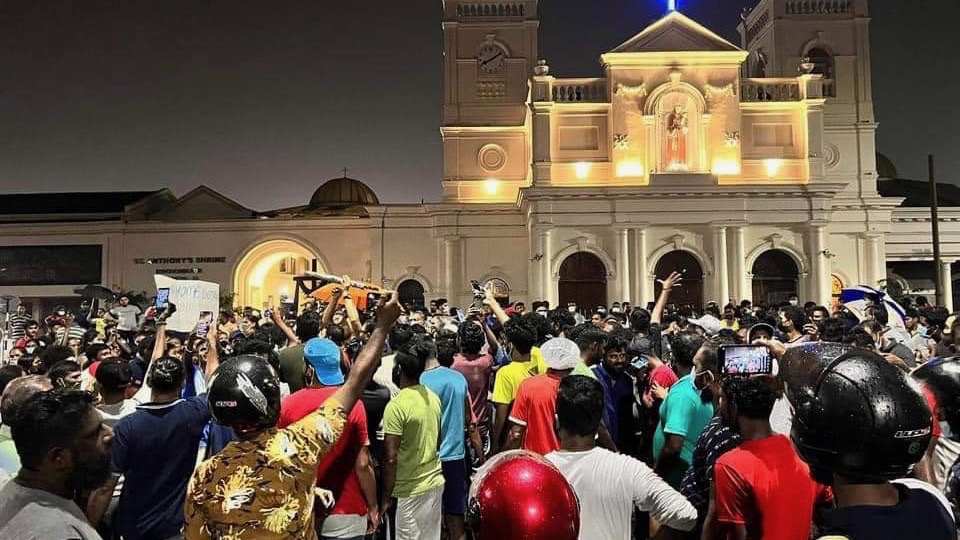The question of ‘What next?’ looms large over Sri Lanka after the events of the past three days. Protests are currently jolting major cities from Kandy to Colombo demanding the resignation of the Gotabaya Rajapaksa-led government.
On Sunday, April 3, in an unprecedented move, the entire cabinet, except for prime minister Mahinda Rajapaksa resigned. On Monday, a four-member cabinet was constituted with the erstwhile justice minister Ali Sabry being appointed as finance minister in place of the president’s brother Basil Rajapaksa. The president also invited opposition parties to join the cabinet although two prominent opposition parties have refused.
Meanwhile, on Monday, close to 2,000 protesters gathered in front of prime minister Mahinda Rajapaksa’s resident in Tangalle, demanding his resignation. Police used tear gas and water cannons on them.
Earlier, on Friday, president Rajapaksa issued an official gazette notification declaring a public emergency and imposed a curfew and a social media blockade, which was later withdrawn. The police have been using tear gas shells and water cannons at protest sites, including on the university premises at Peradeniya, to disperse the gatherings.
Angry citizens however defied all restrictions and took to the streets in protest over the present state of the country and the mismanagement of the economy by the government.
Police use water cannons and tear gas to disperse Carlton House protestors. https://t.co/iCdPLivJZo #lka #lknews #SriLanka #EconomicCrisisLK #SriLankaCrisis #SriLankaEmergency
— News Cutter (@news_cutter) April 4, 2022
#SriLanka: Ongoing protest at Rajagiriya, Colombo #SriLankaEconomicCrisis #lka pic.twitter.com/7FdNI8VsHe
— Meera Srinivasan (@Meerasrini) April 3, 2022
“Go Home Gota”
Since the Sri Lankan government declared a public emergency, social media has been flooded with dramatic visuals of several hundreds of citizens carrying handwritten placards of “Go Home Gota” and oil lamps in the capital blocking roads to express public anger over the government’s latest actions. The southern towns of Galle, Matara and Moratuwa also saw anti-government protests. Similar demonstrations were reported in the northern and central regions. Students, journalists, lawyers and rights groups have all joined the protests on the streets.
The decision to declare the emergency came after protests escalated towards the end of March. Massive protests were launched by citizens on March 31. Protesters marched to the president’s residence to demand his resignation. They also demanded that the ruling SLPP government step down. The government deployed the Special Task Force (STF) which used tear gas and water cannons to dispel the crowd gathered around the president’s residence. A bus was also set on fire by the protesters.
At least 4 journalists, covering Thursday (31) night protest near #SriLanka President @GotabayaR residence have been arrested & brutally assaulted by #SriLanka police while 3 more are treated at the hospital for the injuries inflicted by armed troops deployed in the area. 🧵 pic.twitter.com/GPA9EqX76T
— JDS (@JDSLanka) April 1, 2022
According to local media, around 54 protesters were arrested on the night of March 31. At least 35 people were also injured, leading to a tense situation in several parts of Colombo.
Footage, police unit armed with clubs stops a civilian vehicle, prevents it from proceeding…from the conversation this appears from a suburb near @GotabayaR private residence where protests turned violent #SriLanka https://t.co/ZbCh9eQODS
— Amantha (@AmanthaP) March 31, 2022
Tourism minister Prasanna Ranatunga termed the protestors as “political extremists.” The government told the media that those who have been arrested for participating in protests will be tried under the notorious Prevention of Terrorism Act (PTA) which has been used in the past by authoritarian governments to suppress public dissent.
Economic crisis going on a national crisis
The waves of protest took place as Sri Lanka’s economic situation plummeted. On March 31, Sri Lankans faced a record 13-hour power cut even as the country completely ran out of diesel. Sri Lanka is currently facing an acute economic crisis that has severely impacted supplies of food, fuel, medicines and even water.
With the inflation rate recorded at 17.8% in March, the fuel shortage has resulted in long queues at gas stations where the military was deployed following protests and deaths of citizens.
The lack of fuel has not only created an electricity shortage but has severely affected every sector from hospitals to the printing press. Ceylon Electricity Board Engineers Union (CEBEU) president Anil Ranjith told local media outlets that only 1,500 metric tonnes (MT) of fuel remains at all except two thermal power stations.





